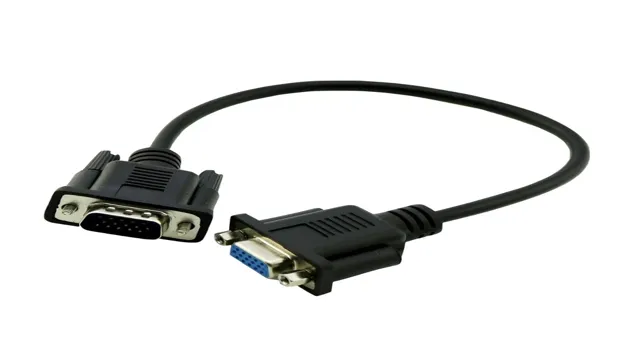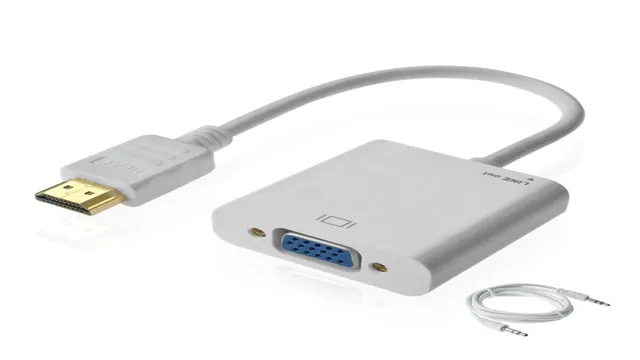Welcome! Have you been struggling to find the perfect connector for your projector? Look no further! Projectors are becoming more and more popular in many settings, from the office to home theaters. However, with so many different types of connectors available, it can be overwhelming to choose the ideal one for your specific projector. Don’t worry; in this blog post, we will help you navigate the vast world of projector connectors, so you can choose the one that best fits your needs and budget.
Think of us as your connector guide, taking you through the pros and cons of each type and helping you make an informed decision. So sit back, relax, and prepare to become a projector connector expert!
Understand Your Projector and Device Connections
When it comes to using a projector, it’s essential to understand the various projector connectors and device connections to ensure a seamless experience. First, determine what type of input ports your projector has. Common types of projector connectors include HDMI, VGA, and USB.
Make sure to match the appropriate cable to your device’s output port. For instance, if your device has an HDMI port, connect it to the projector’s HDMI input port. Additionally, ensure that your device’s display settings are set to “projector” to direct the output to the correct source.
It’s also important to note that some projectors may require additional adapters to connect to newer devices that have specialized ports, such as USB-C. With a little bit of know-how, you can easily set up your projector and device to experience stunning visuals in your next presentation or movie night.
Check the Available Ports and Cables
When setting up your projector, it’s critical to understand the available ports and cables for your device connections. Different projectors have different ports, so it’s essential to check the manual or the box to see what ports are available. Usually, most projectors come with a VGA port, an HDMI port, and a USB port.
The VGA and HDMI ports are the most common and provide the best picture quality when used with compatible devices. The USB port, on the other hand, is not primarily designed for video connections but for power supply, firmware updates, or multimedia playback. It’s always advisable to use the appropriate cable for each port to avoid any compatibility issues.
HDMI cables are the best option for most modern projectors since they provide high-definition audio and video connections. If the device you’re connecting to the projector uses VGA instead, you’ll need to use a VGA cable. Ensure that the cables and ports you use are compatible with both your projector and the device you’re connecting to get the best possible image and sound quality.

Identify the Projector Connector Type Needed
When setting up a projector, understanding the different types of connector options available is essential. Most modern projectors come with a range of connection ports, including HDMI, VGA, DVI, and DisplayPort. These ports can vary depending on the model and brand of your projector, so it’s important to check the manual or do some research to determine the specific connector type needed.
It’s also crucial to consider the devices that will be connected to the projector, such as laptops, gaming consoles, or DVD players, as each will require a particular connector type. For example, newer laptops may use HDMI, while older ones may require VGA. Understanding your projector and device connections will help you choose the right cable for a seamless setup and avoid any compatibility issues.
Select the Right Projector Connector
When it comes to selecting the right projector connector, there are a few things to keep in mind. Firstly, identifying the type of input/output you need is crucial. Do you require HDMI, VGA, or DisplayPort? Knowing this will make your search for the right connector much easier.
Secondly, ensure that the connector you choose is compatible with both your projector and your device. It’s frustrating to purchase a connector just to find out that it doesn’t work with your equipment. Lastly, consider the length of the cable you need.
Will the projector be far away from your device, or will it be close enough that a short cable will suffice? These are all important factors to consider when selecting the right projector connector. Don’t rush your decision and take the time to research and compare different options to find the one that fits your specific needs.
Consider Compatibility with Your Devices
When selecting a projector, it’s essential to ensure compatibility with your devices, whether it be a laptop, tablet, or even a gaming console. The right projector connector can make a significant difference in the quality of the image and sound output. HDMI connectors are the most common and versatile, offering high definition and digital audio capabilities.
However, older devices may require VGA or RCA connectors, which are typically found on older laptops and DVD players. It’s also essential to consider the length of the connector cable, as longer cables can result in signal degradation. Ultimately, choosing the right connector depends on the devices you plan to use with your projector.
Taking the time to research and ensure compatibility can prevent frustration and ensure a seamless viewing experience.
Evaluate Connector Quality and Durability
When it comes to selecting a projector connector, it’s important to evaluate the quality and durability of the connector before making a purchase. A high-quality connector can make all the difference in the clarity and reliability of your projector’s image. Look for connectors that are made from sturdy materials and are rated for high resolutions and refresh rates.
It’s also important to consider the connector’s compatibility with your existing equipment. For example, if you already have an older projector, you’ll want to ensure that your new connector fits the older port. Don’t overlook the importance of a well-made connector, as it could save you time and money down the line by preventing connectivity issues and reducing wear and tear on your equipment.
Overall, taking the extra time to research and select the right projector connector will make a noticeable difference in your viewing experience.
Choose the Right Length and Design
When it comes to selecting the right projector connector, it’s important to pay attention to both the length and design. The length of the connector should be enough to reach from your projector to your chosen input device without any strain or stress on the wires. Additionally, the design of the connector should be compatible with your projector and input device.
There are various types of connector designs available, including HDMI, VGA, DVI, and DisplayPort, each with its own benefits and limitations. It’s crucial to select a connector that will provide the best possible picture and sound quality for your particular setup. Whether you’re using your projector for business presentations or home entertainment, choosing the right connector is essential for a seamless and enjoyable viewing experience.
So, take the time to research and find the optimal connector for your specific needs, and you’ll be able to enjoy your projector to its fullest potential.
Use Your Projector Connector Effectively
When it comes to getting the most out of your projector, knowing how to use your projector connector is essential. A projector connector is typically used to connect your projector to various input sources, including laptops, smartphones, gaming consoles, and cable boxes. This ensures you can enjoy high-quality images and sound from your projected content without any hassle or limitation.
To use your projector connector effectively, first, identify the type of connector you need by checking the input ports available on your projector and input source. You should also take the time to familiarize yourself with the different types of cables available, such as HDMI, VGA, and DisplayPort. Remember that the right connector will depend on the output port of your input source, so make sure to check your device’s manual or website to ensure compatibility.
By mastering your projector connector, you can ensure seamless connectivity, clear images, and a hassle-free viewing experience.
Connect Devices and Test for Compatibility
When it comes to using your projector, connecting it to your other devices can sometimes be a hassle. Whether it’s a laptop, gaming console, or streaming device, compatibility issues can arise if you’re not careful. That’s why it’s important to use your projector connector effectively.
The first step is to identify the type of connector you need for your device, whether it be HDMI, VGA, or USB. Once you have the right connector, make sure to plug it in securely to both your device and projector. It’s also a good idea to test the connection beforehand to ensure that there are no technical difficulties.
Compatibility issues can be frustrating, but with the right equipment and a little bit of patience, you’ll be able to enjoy your projector to its full potential. Remember to keep things simple and don’t hesitate to reach out for help if you need it.
Maximize Your Display Quality and Resolution
Connecting your projector to a high-quality connector can make all the difference in maximizing your display quality and resolution. One often-overlooked aspect when it comes to projectors is the connector used. HDMI connectors are generally the most effective for maintaining high resolution and signal clarity.
Additionally, using shorter cables and avoiding the use of adapters can also improve the overall quality of your display. Using the right projector connector also allows you to enjoy a seamless viewing experience without any lag or distortion. So, before you settle for any connector, do your research and invest in the right one for your projector.
Doing so will ensure you get the most out of your projector and enjoy a high-quality viewing experience every time.
Shop for and Buy a Projector Connector
If you own a projector, chances are you will need a projector connector to connect it to your computer or other devices. The choice of the connector will depend on the type of input and output ports on your projector and the device you are connecting it to. The most common types of projector connectors are VGA, HDMI, DisplayPort, and USB, each of which has its own advantages and limitations.
VGA is the oldest type of connector and is still in use, but it offers a limited resolution and does not support audio. HDMI, on the other hand, supports high-definition video and audio, making it ideal for home theater systems. DisplayPort is a newer standard that supports higher resolutions and refresh rates than HDMI but is not as widely supported.
Finally, USB connectors can be used for charging or data transfer and are ideal for displaying PowerPoint presentations. Whatever your requirements, you can find a wide range of projector connectors online or at your local electronics store, so you can enjoy your projector without any connectivity issues.
Conclusion
In conclusion, the projector connector is like the bridge between your device and the big screen. Without it, your PowerPoint presentation, movie night or gaming setup would be doomed for a small screen fate. So, for all the times the projector connector has saved your presentation, let’s raise a glass (or a HDMI cable) to this unsung hero of the tech world.
“
FAQs
What types of projector connectors are available?
There are several types of projector connectors available, including HDMI, VGA, DVI, and DisplayPort.
Can I use an adapter to connect my projector to my computer?
Yes, you can use an adapter to connect your projector to your computer if they have different types of ports.
How do I know which connector my projector supports?
You can usually find information about which connectors your projector supports in the user manual or on the manufacturer’s website.
Can I connect my phone or tablet to a projector?
Yes, you can connect your phone or tablet to a projector using an appropriate adapter or cable, such as an MHL adapter or a Lightning to HDMI cable.
